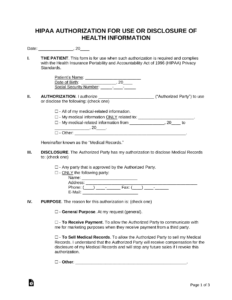In today’s increasingly interconnected world, the healthcare industry is undergoing a digital transformation. As a result, healthcare providers are increasingly relying on electronic signatures to create and transmit patient records more efficiently and increase productivity. This has created the need for an electronic signature policy template for healthcare organizations, which can help ensure that the electronic signature process is legally compliant and protects patient information.
An electronic signature policy template for healthcare can help organizations establish consistent guidelines for the use of electronic signatures, including the types of documents that can be electronically signed, the methods of electronic signature that are acceptable, and the procedures for obtaining and verifying electronic signatures. Additionally, it can help ensure that electronic signatures are used in a manner that is compliant with applicable laws, regulations, and standards.
What to Include in an Electronic Signature Policy Template for Healthcare
Purpose of the Policy: Clearly state the purpose of the electronic signature policy and its scope, including the types of documents that are covered by the policy and the healthcare providers to whom the policy applies.
Definition of Electronic Signature: Provide a clear definition of what constitutes an electronic signature under the policy, including both handwritten and digital signatures.
Authorized Signers: Specify who is authorized to electronically sign documents on behalf of the healthcare organization and the requirements for electronic signature credentials.
Procedures for Obtaining and Verifying Electronic Signatures: Outline the steps involved in obtaining and verifying electronic signatures, including the methods of electronic signature that are acceptable (e.g., digital signatures, scanned signatures, or handwritten signatures captured electronically) and the procedures for identity verification.
Security Measures: Describe the security measures that must be in place to protect patient information, including appropriate encryption and authentication protocols and procedures for safeguarding electronic signatures from unauthorized access or alteration.
Retention and Archiving: Specify the requirements for retaining and archiving electronically signed documents, including the format and duration of retention and the procedures for accessing and retrieving archived documents.
Implementation and Enforcement of the Electronic Signature Policy
Communication and Training: Ensure that all healthcare providers who are subject to the policy are aware of the policy and have received adequate training on the procedures for using electronic signatures.
Monitoring and Auditing: Establish a system for monitoring and auditing the use of electronic signatures to ensure compliance with the policy and to identify any potential risks or vulnerabilities.
Enforcement and Consequences: Define the consequences for non-compliance with the policy and the procedures for investigating and resolving any violations.
Review and Updates: Regularly review and update the electronic signature policy to ensure that it remains compliant with applicable laws, regulations, and standards and to address any changes in technology or business practices.
Conclusion
An electronic signature policy template for healthcare is an essential tool for healthcare providers who want to leverage the benefits of electronic signatures while ensuring compliance with legal and regulatory requirements. By establishing clear guidelines for the use of electronic signatures, healthcare organizations can protect patient information, streamline workflows, and improve efficiency.
It is important to note that the specific requirements for an electronic signature policy template for healthcare may vary depending on the jurisdiction and the specific needs of the healthcare organization. Therefore, it is advisable to consult with legal counsel and IT professionals to ensure that the policy is tailored to the specific circumstances of the organization.
FAQ
What are the benefits of using an electronic signature policy template for healthcare?
An electronic signature policy template for healthcare can help organizations establish consistent guidelines for the use of electronic signatures, ensure compliance with applicable laws and regulations, protect patient information, streamline workflows, and improve efficiency.
What are the key elements of an electronic signature policy template for healthcare?
The key elements of an electronic signature policy template for healthcare include the purpose of the policy, the definition of electronic signature, authorized signers, procedures for obtaining and verifying electronic signatures, security measures, retention and archiving requirements, implementation and enforcement mechanisms, and review and update procedures.
How can healthcare providers ensure compliance with their electronic signature policy?
Healthcare providers can ensure compliance with their electronic signature policy by communicating and training all relevant healthcare providers about the policy, monitoring and auditing the use of electronic signatures, enforcing consequences for non-compliance, and regularly reviewing and updating the policy to keep up with changes in technology and regulations.


